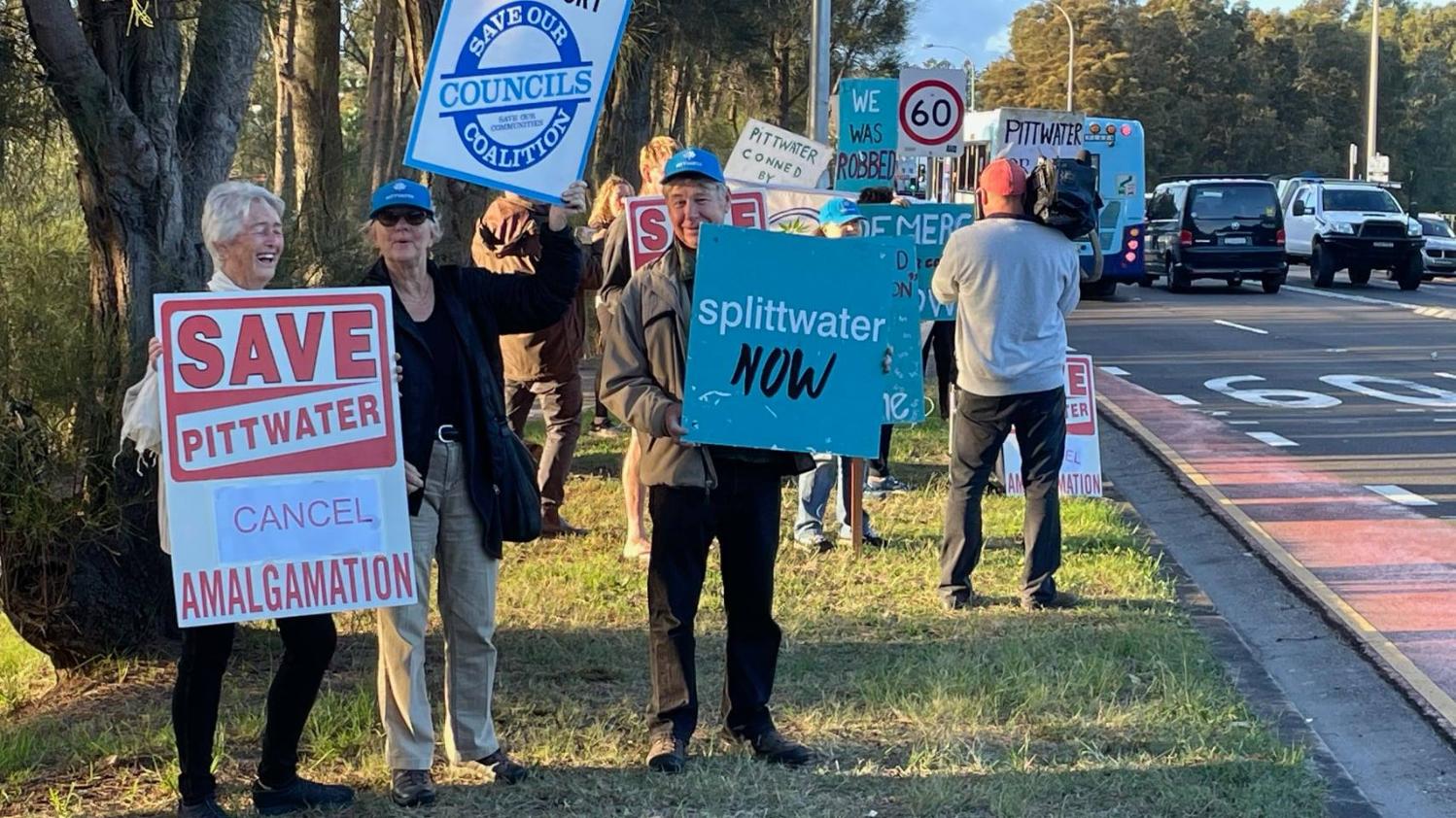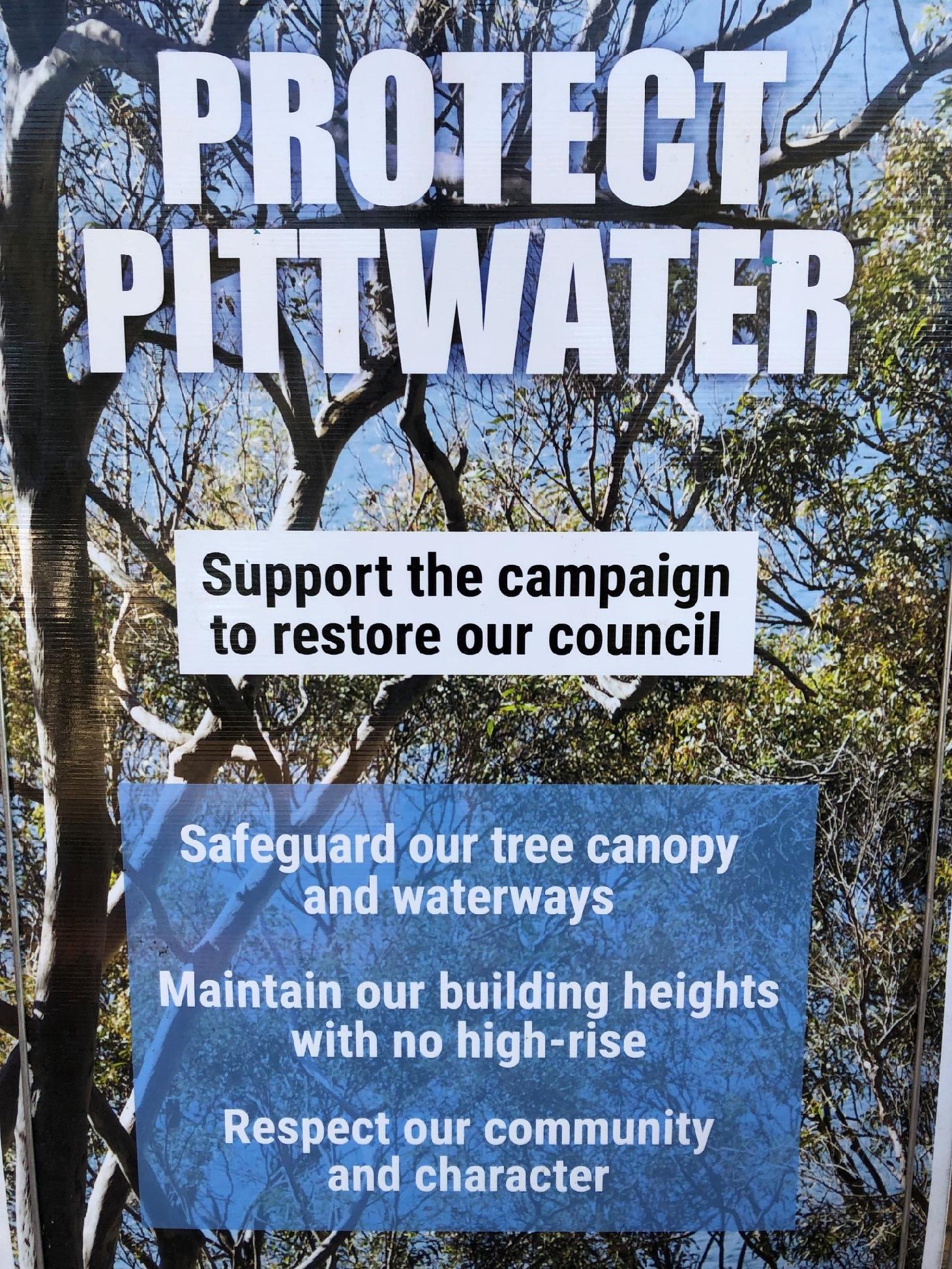Protect Pittwater Associations' New President Simon Dunn, son of first elected Pittwater Mayor, to lead charge to restore Pittwater Council
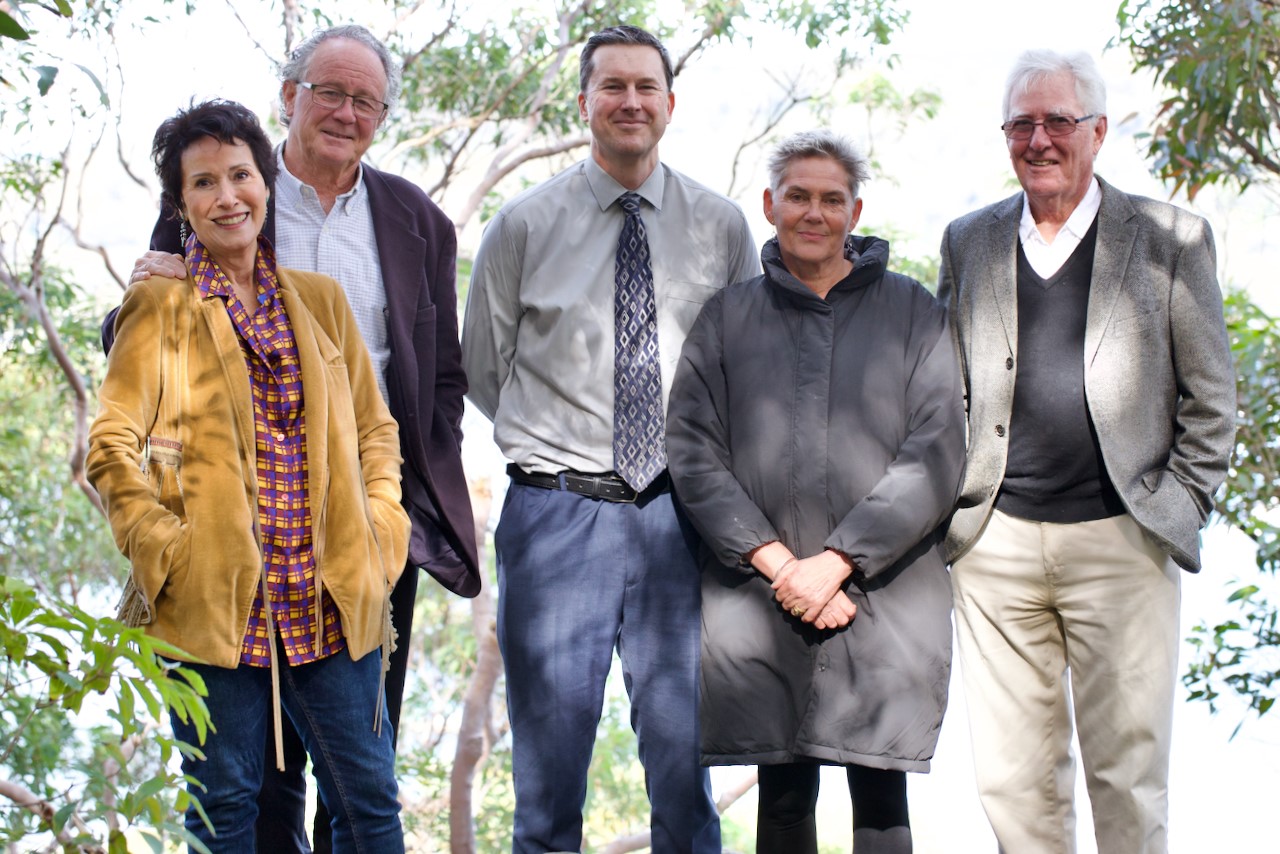
Protect Pittwater Association Committee members June 2023
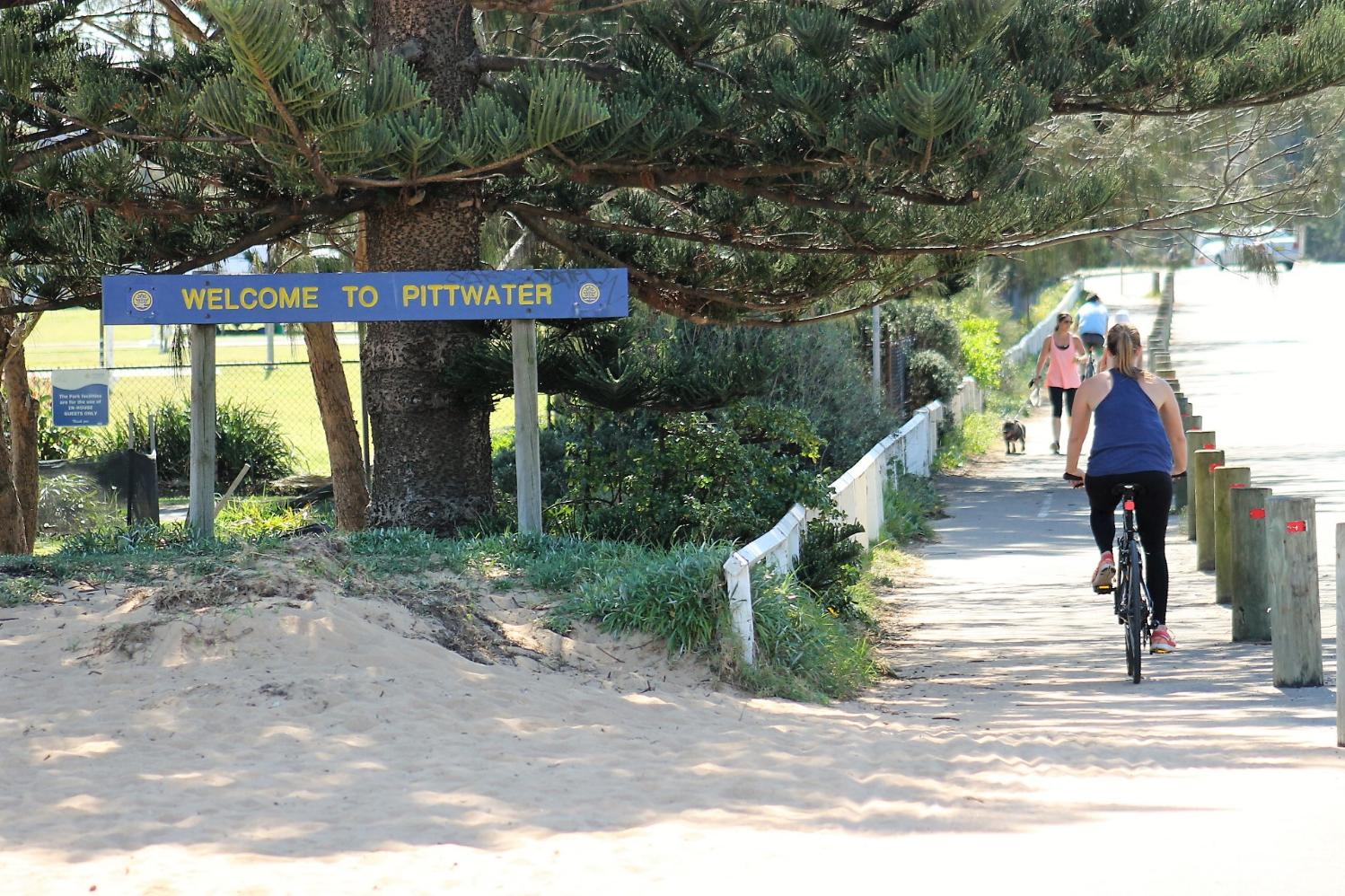
We consider the only future for this area and for the preservation of those ideals and policies for which we stand is to become an independent Shire … the need for this electoral reform has been clearly and sufficiently demonstrated to enable the Government to come to a decision and no longer forestall the issue. Put simply we call upon the Government to put the matter now to the people of A Riding to determine.
Warringah Shire Councillors Robert Dunn and Eric Green, representing A Riding - 1990
Photo: 'Welcome to Pittwater signage at North Narrabeen, where the Pittwater Council LGA commences, in 2013
Going into the 2023 State Election Pittwater Online sought comment from the then opposition Minister for Local Government, Greg Warren MP, whether an elected Labor Ministry would honour their pledge to restore Pittwater Council. Mr. Warren confirmed in January 2023 through his policy advisor that:
''a NSW Labor Government will not support the forced merger of local councils, nor will it support any forced demerger. Rather, this must be done voluntarily with the clear support of local residents as confirmed through a local plebiscite.
To this effect, a NSW Labor Government will legislate to put into place independent mechanisms to enable this to occur.''
In recent weeks Protect Pittwater members have once again been gathering signatures on a petition for a plebiscite and a return of Pittwater Council following the first one becoming ‘lost’ and then being rejected by the then Coalition Minister for Local Government Gabreille Upton, despite meeting the criteria under the Local Government Act for the same.
In May the Protect Pittwater Association held their AGM and elected a new committee which is led by a new president Simon Dunn, son of former and first elected Pittwater Mayor Robert Dunn, one of the original campaigners for the secession of Pittwater from Warringah Council. Pittwater Council seceded from Warringah Council in 1992 but was dismissed and merged into Northern Beaches Council on May 12, 2016, despite a Pittwater Council survey that found 89 per cent of its residents were opposed to the amalgamation.
Simon Dunn said on Saturday June 10th;
“Never has there been a more critical time to engage the Pittwater community to protect the natural environment of Pittwater. A change of State Governments presents both a threat of increased reliance on arbitrary housing targets, but also an opportunity to hold NSW Labor to its election promise to allow communities who opposed the undemocratic forced amalgamations to return to their former boundaries and restore true local government.’’
The honeymoon for the oversized Northern Beaches Council is coming to an end with the temporary boost in State funding to smooth over the community anger now drying up and the impossibility of such a large organisation being able to provide any semblance of local government now resulting in a mass exodus of staff and a lack of community engagement.
More alarmingly, the promise of allowing each former council area to maintain its own planning controls has been forgotten and drastic rezoning looms large under the guise of so called “harmonisation”.
With the recent passing of many of the previous great protectors of Pittwater, it is time for the next generation of Pittwater residents who appreciate the unique and beautiful characteristics of this great area we are blessed to live in to step up and join the push to restore Pittwater Council as the great protector of our natural environment it once was.”
‘’I am honoured to have been recently elected President of Protect Pittwater and to take up the cause so passionately championed by my predecessor, the late Bob Grace and by my own father, the late Robert Dunn.’’ Mr. Dunn told Pittwater Online News
‘’I grew up with the fight to establish Pittwater Council at times dominating our family life and now that I have my own young family I appreciate the sacrifice made by both my parents and the large group of community leaders who supported the cause to give the Pittwater Community the control of its own unique environment. Whilst it would be the easier and perhaps more sensible option for me not to get involved, I can’t help but feel that the chance to restore Pittwater Council and prevent a total loss of environmental protections is a now or never moment for this generation.’’
Since Pittwater Council was forcibly amalgamated with Warringah Council on May 12th 2016 residents of ‘the northern end of the northern beaches’ have sought to restore that council.
In May 2017 the Protect Pittwater Association was formed to progress that aim.
On June 22nd 2017 the Upper House passed The Local Government Amendment (Amalgamation Referendums) Bill 2017 to end forced council amalgamations.[Long Title: ‘’An Act to amend the Local Government Act 1993 to require referendums to be held in relation to the amalgamation or proposed amalgamation of local councils.’’]
All parties other than the then Coalition government voted to halt all outstanding forced amalgamation proposals until residents were given their say in a binding referendum. The bill also gave residents in councils that had been forcibly amalgamated the right to a binding vote on de-amalgamation. The Greens also successfully moved an amendment to ensure that no council amalgamation can ever happen again without first holding a referendum in local communities. The aim was to protect local democracy in the future.
The Save Our Councils Coalition (SOCC) said then a vote for support of this bill in the Lower House would be difficult but that its passing showed the stature of the Upper House of the NSW State Parliament as the People’s House and this was a vote for restoration of democracy for local communities and the many councils already forcibly merged by the Coalition State Government.
“Thursday’s June 22 vote is an embarrassment for the Berejiklian Government that deceptively bypassed the Parliament to ram through its despised forced council amalgamation agenda. The Upper House has shown it will not put up with Parliamentary action without the approval of their MLCs,” SOCC spokesman Phil Jenkyn said.
“We place a very high value on what the Upper House has done and it is now time for all those Liberals and National Party members who secretly oppose this forced merger agenda to stand up and vote with the other parties in the Lower House and pass this bill. Otherwise many of them stand to lose their seats at the next State election,” Mr. Jenkyn added.
The Bill did not pass the then Coalition ruled lower house and lapsed on February 2nd 2018.
Protect Pittwater members had been gathering signatures for a return of the Pittwater Council and presented the required number to then NSW Local Government Minister Gabrielle Upton on May 12, 2018, however, the group did not receive advice rejecting it until February 20, 2020 – the rejection stating it was not accepted as that Local Government Minister now required a 10% across the WHOLE of the new Northern Beaches Council LGA they had created – not just 10% within the former Pittwater Council LGA boundaries.
The Office of Local Government wrote to the group saying that:
“… the proposal … does not meet the legal requirement of being certain, nor is it supported by an appropriate minimum number of electors as required by the Act”.
“Given that our proposal was composed with the help of two barristers, Protect Pittwater will now take advice to consider our next course of action,” the group said in a statement.
Chapter 9 How are councils established? of the Local Government Act states:
Part 1 Areas
Division 2 What must be done before areas can be constituted?
215 Who may initiate a proposal?
(1) A proposal may be made by the Minister or it may be made to the Minister by a council affected by the proposal or by an appropriate minimum number of electors.
(2) An appropriate minimum number of electors is—
(a) if a proposal applies to the whole of an area or the proposal is that part of an area be constituted as a new area—250 of the enrolled electors for the existing area or 10 per cent of them, whichever is the greater, or
(b) if a proposal applies only to part of an area—250 of the enrolled electors for that part or 10 per cent of them, whichever is the lesser.
On May 2nd 2021 Protect Pittwater announced it had launched a new petition to get Pittwater Council back. On May 13th, 2021 the NSW government wrote a new opportunity for fully funded council demergers, updating local government laws to allow for council-initiated proposals within a fixed time frame.
Save Our Councils Coalition vice president and sacked when the forced amalgamations were enacted Pittwater Councillor Sue Young said then that under changes passed by both Houses of the NSW Parliament in the Local Government Amendment Bill 2021, councils amalgamated in 2016 would be able to launch demerger bids within 10 years of their establishment.
However this was applying a 'across the whole LGA' mark once again. As Warringah Council had advocated and campaigned for the amalgamation along the same lines and with the same numbers used by the Protect Pittwater petition, and with a larger former Warringah Council population that had expressed from the outset it wanted Pittwater Councils' rates back at its disposal for facilities in that former Warringah LGA (February 2016 Amalgamations Public Inquiry at Mona Vale Golf Club), this too would be a fruitless exercise of ever shifting goal posts and ever changing applying of some sections of the Act while ignoring applicable sections.
In the past several weeks renewed calls by residents for a return of Pittwater Council state the former government's policies, modified Acts and requirements have disenfranchised residents participation in shaping their community, or ignore their 'feedback' as it does not fit in with what is planned. Approved developments, whether by the council or state appointed panels, that raze once green areas, fill the whole block with bulky buildings that breach height restrictions are cited as 'a deliberate destruction' or 'uglification' of Pittwater'.
However, the newly voted in NSW Labor Government has maintained throughout the years since that May Day in 2016 that it would support communities and residents in their aim to restore their Councils.
At a 2018 community forum hosted by the Protect Pittwater Association, to bring residents up to date on the impact of the council merger of Pittwater, Warringah and Manly Council - as well as efforts to restore Pittwater, then NSW Labor Local Government spokesman Peter Primrose said that if Labor won government at the next state election, it would run binding plebiscites in the former local government area, following a petition from local residents.
“Certainly, if we form government and I become the minister for Local Government, we will join with the other political parties - other than the Liberals and Nationals - and we will introduce legislation to allow you to voluntarily demerge and bring back Pittwater council,” he told the forum.
Former NSW Labor Premier Barrie Unsworth, who was also in the audience of that forum, and has attended many Protect Pittwater rallies and community meetings since, called on residents to join the Protect Pittwater Parliament House rally on May 15, to show MPs that there is deep dissatisfaction in the area, and said: “then we might start to get results”.
In March 2023 Council demerger campaigners began distributing a new “Bring Back Pittwater Council” sticker in the leadup to the NSW state election. The sticker, designed by retired Avalon art teacher Pru Wawn, depicts the Pittwater symbol of a Mangrove leaf, in royal blue.
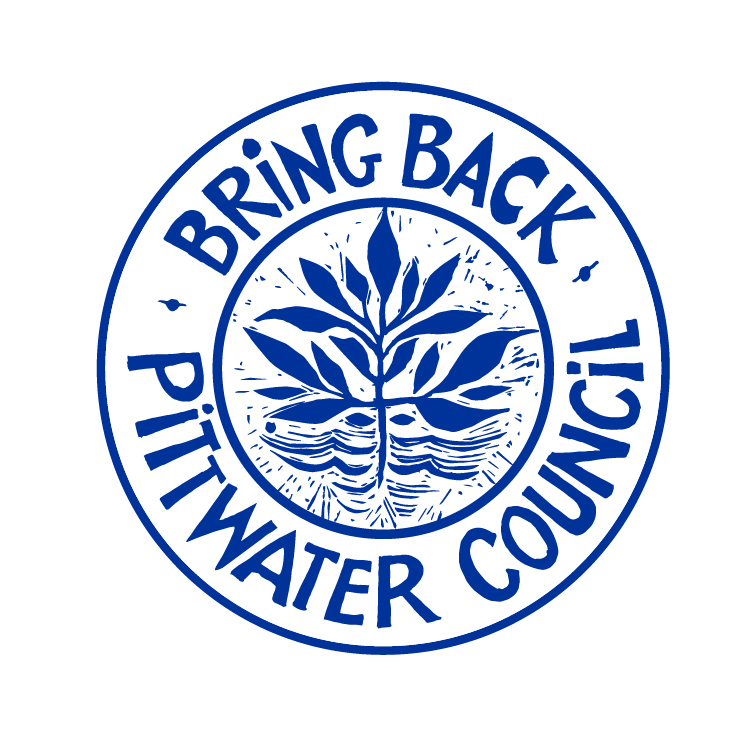
The group, including members of Protect Pittwater, Save Our Councils and the Demerge NSW Alliance, were distributing the stickers and gathering signatures in Avalon for a demerger petition and Pittwater Conservation Zones petition.
Former Pittwater Councillor Sue Young was delighted by the support they received.
“It was very encouraging to see the number of people who would like to see Pittwater Council back again, and it was surprising the number of people who were still unaware of the proposed rezonings in Pittwater,” Ms Young said.
“This wouldn’t be happening if we still had Pittwater Council.
“Young Mums were very vocal about a lack of maintenance, particularly of our parks, and a loss of sense of community.
“And it appeared that many residents don’t know what’s going on with the Conservation Zones Review.
“The council should have notified everybody in the LGA whether they were directly impacted or not by the proposed changes.”
Northern Beaches Council conducted a Conservation Zones Review last year, that was publicly exhibited, proposing the former Pittwater Area would lose 3,613 Conservation Zones, compared to 54 in the former Manly and a total of one in the former Warringah.
Staff received 935 public submissions regarding the review, 60 per cent of which were from residents of the former Pittwater area.
Ms Young said the campaigners were providing information, rather than “telling people what to think”.
“But it seemed pretty clear this morning what they want,” she said.
At a February 2023 Community Forum, the third, well-attended, planning forum organised by the community in the last few months, it was revealed that Pittwater could legally keep its own planning rules but upgrade environmental protection in the LEP, as part of the amalgamated Northern Beaches Council area, rather than having those values subsumed into a across the LGA Local Environment Plan. The decision to adopt one LEP and one LSPS across the LGA without any explicit discussion about the reasons for this or necessity to do so, was made by the Northern Beaches Council at its November 27, 2018 meeting.
Local Strategic Planning Statement, touted as ‘to guide future land use planning and development’, and required under the quickly formed Great Sydney Commission after the enforced amalgamations, now the Greater Cities Commission, is purported to have a mandate ‘to coordinate and align the planning that will shape the future of the six cities region’.
However subsequent changes and overruling of still in place DCP’s and LEP’s and a Northern Beaches Council that continues erroneously recommending developments be approved in contravention of these, as in the recent instance of the proposed development for the Palm Beach Fish and Chip site, or that passed for a developer to funnel traffic on to Robertson Road Newport, despite Pittwater Council having adopted that area as a community space and site for a future plaza in December 15 2014 [Pittwater DCP; Appendix 12 Newport Village Commercial Centre Masterplan], or the first decisions made under these schemes [Sydney North Planning Panel - Crystal Bay Seniors Housing Development first decision 2018 + Warriewood Development changing Pittwater LEP to build 22 dwellings in Narrabeen Creek Buffer zone], and continued - Mona Vale overdevelopment in flood zones, have shown what the truer definition of 'scale and capacity' was meant when given as the reason for the forced amalgamations and has led to the ruination of sensitive sites, some with environmental hazards such as landslips or flooding, could be mandated after the forced amalgamations.
Greens Councillor Miranda Korzy submitted a Motion to the February 28th 2023 Northern Beaches Council Meeting ‘Conservation Zones Motion’. The motion reflected the discussions and motions passed at the Saving Pittwater from the Chainsaws forum earlier that month, the third, well-attended, planning forum organised by the community in the last few months.
At the Saving Pittwater from Chainsaws Forum Environment and Planning lawyer James Ryan revealed Pittwater could not only legally keep its own planning rules but upgrade environmental protection in the LEP, as part of the amalgamated Northern Beaches Council area.
The Council's recent Conservation Review ignored the Pittwater Council's 60/40 ruling for Environmentally sensitive blocks in Pittwater, and 50/50 for all others, as in the Pittwater 21 Development Control Plan (DCP). Planners told councillors they estimate that in the former Pittwater LGA, 3,613 properties will move from a Conservation zone to an R (residential) zone, and 1,328 from an R zone to a C zone, resulting in an overall loss of 2,285 properties from C zones.
The former Manly LGA will lose just 54 properties from the C zone while the former Warringah will lose just 1.
Residents state this document has been drafted so a new DCP will fit in with what occurs in the former Warringah Council area.
''The 'Warringah methodology and formulas' are already being seen in over the height limit and filling the whole block developments being passed by council show little knowledge of or respect for what was formulated by residents and adopted for Pittwater by Pittwater Council. It's as though this approach commenced as soon as the amalgamated councils did and everything else other than Warringah council practice and approach was thrown out.''
Residents state that DA breaches have had a very detrimental effect, including:
- an accumulative loss of local native flora and fauna, many of it endangered (one report suggests a devastating loss of 19,650 trees from DAs alone since 2018, many mature local natives); and
- an addition of ugly, monster homes (many breaching the 8.5 metre height, some by more than a whopping 40%) - and other developments which do not fit the local character of the area.
Many of the breaches concern clear cut rules such as the 60:40 rule under C1.1 Landscaping, 4.3 Building Height, 7.6 Biodiversity, B4 Controls Relating to Natural Environment, B3 Hazard Controls and B5 Water Management, along with breaches of not blocking out the view of the public along our coasts and waterways, C1.3.
Trees that are required to be retained suddenly die, some poisoned deliberately, some with their roots flooded until they fall over.
In every suburb and every street plans with height breaches, to fill the whole block with concrete, to remove all vegetation or hillside, are passed by the council.
Along with the required by State Government housing densification, drafted and passed by the Northern Beaches Council to change Narrabeen, Newport, Mona Vale and Avalon Beach to medium density sites, the destruction of what many love about Pittwater is already taking place and scheduled to be increased.
However, on a council dominated by former Warringah councillors and vested Liberal party interests being taken to the 2023 State Election, Cr. Korzy's Motion was quashed.
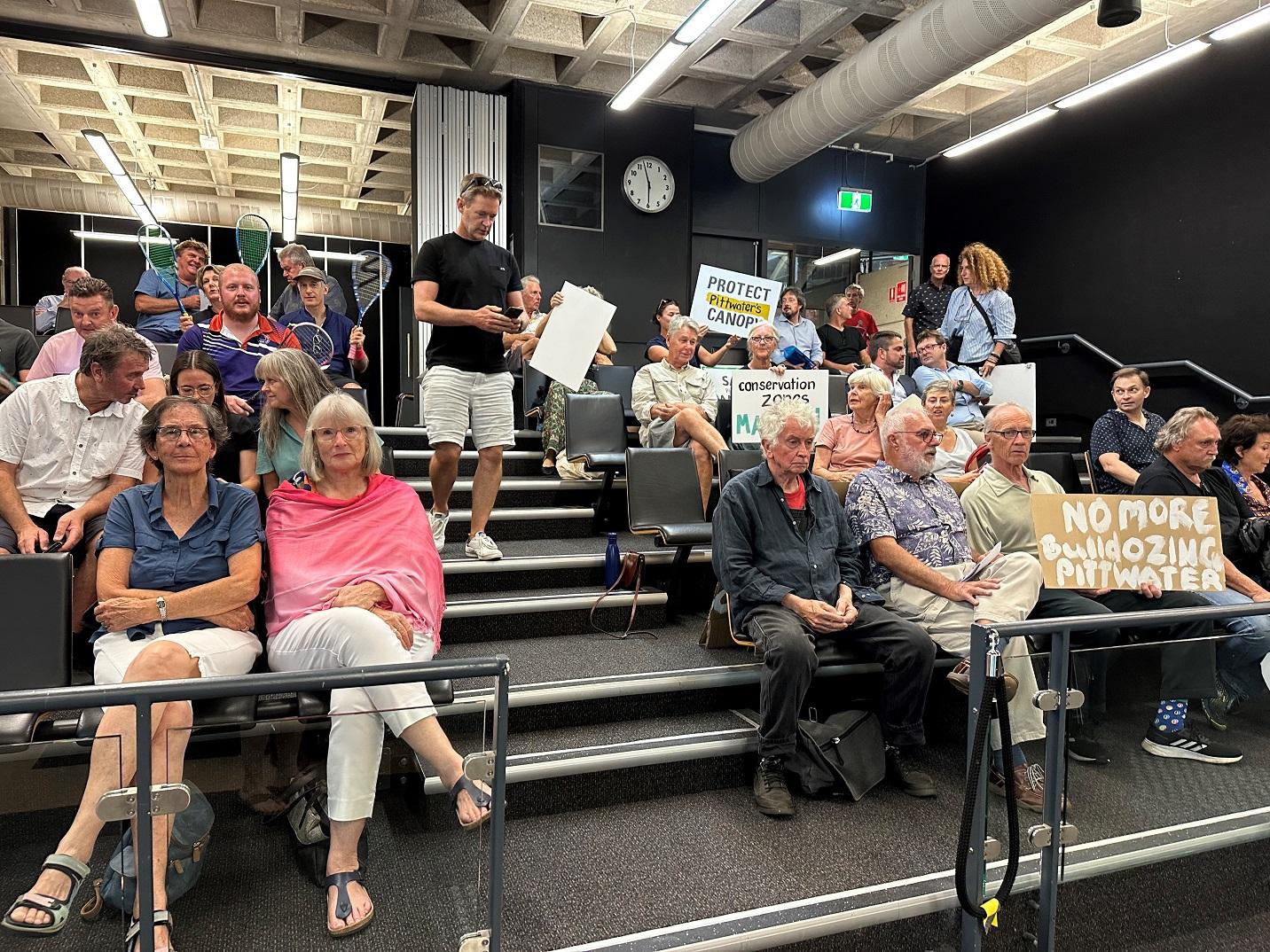
Even in late 2022 the policies and strategies to facilitate developers were being mandated by the former NSW Coalition government.
In December 2022 the incumbent State Government announced it would rezone areas to deliver 70,000 homes by June 30, 2024 and it would be in charge of assessing these. The bulk of these sites are in Western Sydney at present, on or adjacent to Sydney's last koala population and its habitat. Under the Rezoning Pathways Program, developers can nominate rezoning proposals for more than 1,000 dwellings on sites in metropolitan NSW and at least 300 dwellings in regional NSW. These proposals would bypass councils and instead be assessed by the state’s planning department.
Despite the major implications of the scheme, the NSW Government failed to detail how local provisions will be considered when these residential developments are assessed and what community consultation, if any, will occur. LGNSW President Darriea Turley AM said the new program was the latest example of the NSW Government cosying up to property developers at the expense of councils and the communities they represent.
“The changes that are being proposed here would affect every council area in the state. It also brings into question what, if any, consideration will be given to existing local plans and policies when major housing developments are being assessed," Cr Turley said.
In the final days before caretaker mode for the NSW election, the DPE quietly dumped A new approach to rezoning in NSW. One of the central tenets of the reform was to add an additional appeal mechanism (there is already one in place – more on that later) for industry that would have stripped councils from having the final say in rezonings.
The appeal to a NSW DPE appointed Planning Panel would’ve been able to overrule councils and approve or make amendments to proposals.
The stated aim of this “reform” was to reduce the timeframe for rezonings and to “overcome delays and progress rezonings that are consistent with strategic plans”.
This approach would have kept bad planning proposals (rezonings) alive in the system and emphasised a “development facilitation” culture, rather than a public interest one, where anyone who tries hard enough for long enough would eventually succeed in their rezoning plans.
An earlier iteration of this reform was offering developers a cash-back planning guarantee, whereby they’d get a refund for failed speculative spot rezonings.
In reality, the reform would have undermined the strategic plan-led system (that is, strategic plans driving planning decisions) and would have diminished the importance of strategic planning. This was not onlu about keeping bad proposals alive, to further shift the balance of power away from councils and their communities, it would have made spot rezonings (planning proposals) more like development applications (DA), rather than a genuine policy development exercise.
The increased ability for forum shopping would have reinforced the signal to industry that persistence will get a negotiated outcome – just like a DA.
The Planning Institute of Australia stated that the “measures intended to elevate proponent-led planning proposals would not be in the public interest”.
The former Coalition government's December 2022 decreed Rezoning Pathways Program, however, is still in place.
The multiple voices and groups speaking up throughout everything that has occurred since May 12th 2016, even into recent days, has coalesced the Pittwater community's belief that the forced amalgamations were to facilitate the agenda of developers and undermine and remove a democratic local voice and local protections.
Joining Simon Dunn on the Protect Pittwater Association Committee are Pittwater Environmental Heritage Group co-founder Anna Maria Monticelli, Amanda Robson, Peter L’Green, Trevor Harrison and Guy Finlay.
Anna Maria Monticelli, Secretary and Public Officer, said on Saturday,
“I’ve spent over 40 years surrounded by National Parks, reserves full of wild life, extraordinary trees and pristine beaches. Why would I not fight to save Pittwater for future generations. One thing I’ve learned in my long fortunate life is that unless you fight for something you believe in nothing will happen.”
Cree Indian saying:
“Only when the last tree has died
And the last river been poisoned
And the last fish been caught
Will we realise
We cannot eat money.”
Amanda Robson, Protect Pittwater Association Treasurer said, “Pittwater is a particularly beautiful and unique environment in the greater Sydney landscape. As such, it should not be subject to the same zoning laws which apply to other high-density residential or commercial suburbs such as Dee Why, Brookvale or Manly. De-amalgamating from NBC is critical to ensure the preservation of Pittwater for future generations, and for the flora and fauna which enrich it.”
Peter L’Green, Committee member, echoed the sentiments of his fellow PPA members;
"To protect Pittwater from over-development and the destruction of the quiet, beautiful and natural places that this community cherishes. That destruction has accelerated since the forced amalgamation to form NBC. It will accelerate again if anything like the rezonings proposed by NBC are passed into law. That cannot be allowed to happen. If demerger is required to protect Pittwater, so be it." he said
Trevor Harrison, Media officer, said;
“Pittwater is not like its NB Council cousins, Manly and Warringah. Its typical landscape is sandstone ridges, steep forested hills and beaches, all bound by the waters of Pittwater, the Hawkesbury and the Pacific; it includes National Parks. Houses largely exist under a tree canopy, often in unfenced areas, allowing the free run of wildlife. These unique landscape and valuable biodiversity characteristics distinguish the Pittwater area from the NB Council areas further south and present an undeniable geological, ecological and emotional substance to our claims for a separate Pittwater LGA.”
Guy Finlay, Committee member, stated;
"I wanted to became involved in Protect Pittwater and the return of Pittwater Council as it’s the only way residents and visitors to this beautiful environment will be served appropriately.
Residents of Pittwater live here for the way it is, not the way some blow ins want to come in, build it up, sell it, flip it for profit and move somewhere else leaving long term residents dealing with the consequences! Consequences that destroy the environment. An environment which is the reason for living in the place you settle.
Greed that took out two public hospitals and built a private hospital that was not prepared for the public! An ER that is now too small and too busy!
Population increase in a dead end Peninsula is not an answer - it’s a death!
Bring back Pittwater Council, We are Pittwater!"
To join Protect Pittwater, sign the Petition or get a Bring Back Pittwater Council sticker please contact the group via email on -: join@protectpittwater.org
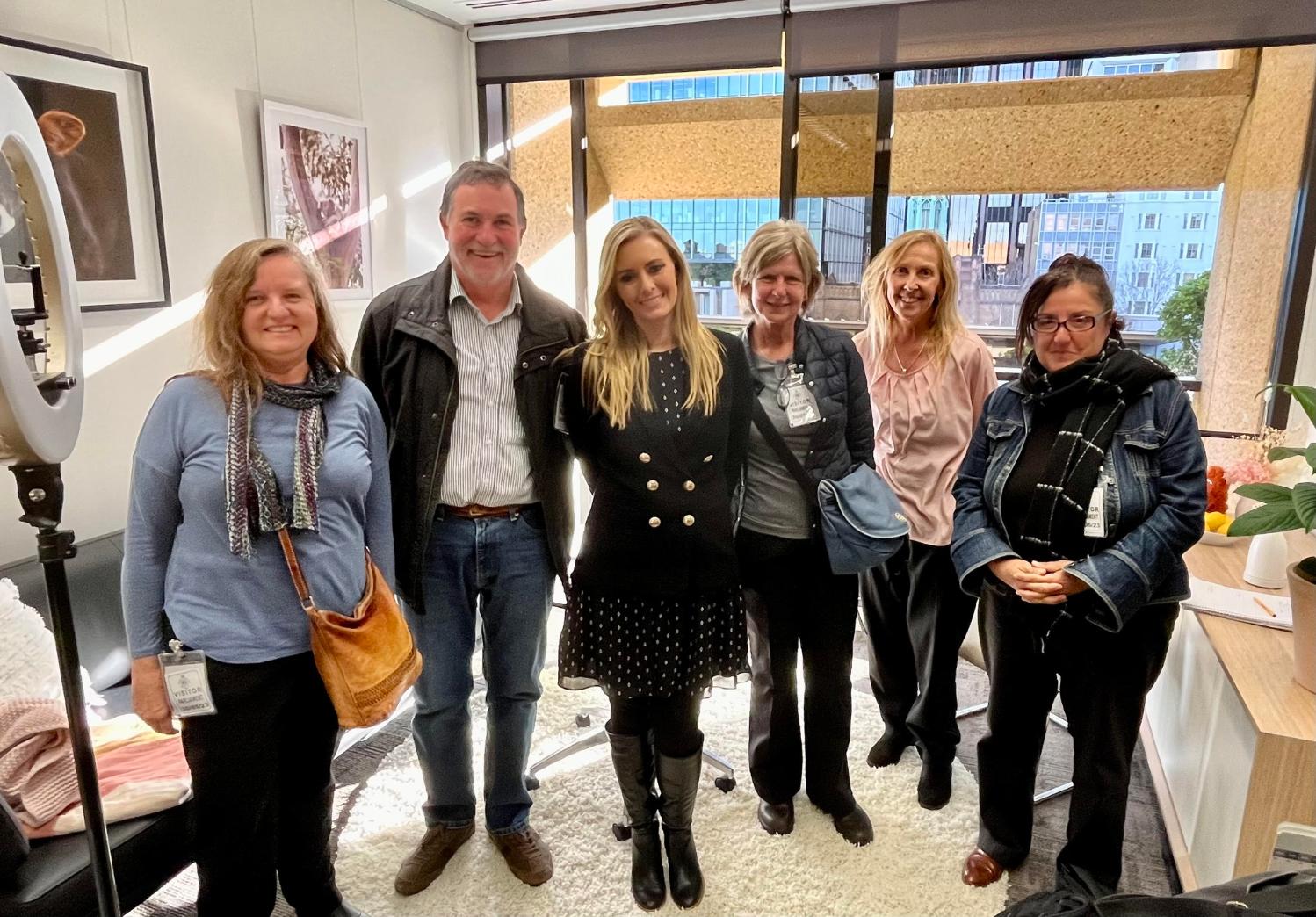
A Demerge NSW Alliance (DNA) delegation visited a number of the NSW Parliament's crossbench MPs on Tuesday June 6 2023 for a chat. We were pleased to find a broad level of support amongst the MPs, many of whom have opposed the 2016 forced amalgamations from the start. Labor policy supports binding demerger plebiscites in any former council area that wants it - so that's what we're working towards. DNA members come from as far north as Guyra and south to Bombala - and include councillors, former councillors and former senior council staff from amalgamated communities.
Photo: DNA members with Animal Justice Party MLC Emma Hurst, image supplied.
References
PITTWATER 21 DCP APPENDICES: Appendix 12 Newport Village Commercial Centre Masterplan; Adopted: 15 December 2014

|
P21_DCP_-_Volume_4_-_Amendment_22.pdf Size : 13653.609 Kb Type : pdf |
- One ‘Mega Council’ Would Be A Disaster For Pittwater - 2014
- Pittwater Residents Urged To Have Their Say On Proposed Council Changes - February 2016 Public Inquiry at Mona Vale Golf Club - February 2016
- Greater Sydney Commission Releases Revised draft North District Plan - October 2017
- Community Forum Calls For Immediate Pittwater Demerger: Pittwater Rally Will Be Held At Parliament House - May 15th - 2018
- Sydney North Planning Panel's First Determination: For Pittwater LEP To Be Amended To Facilitate Crystal Bay Seniors Housing Development To Proceed To Gateway + Change E4 Zone To R2 For All Adjacent Blocks Of Land - June 2018
- Warriewood Development Approved By NSW Planning Department Confirms Community Perception Of False Claims Of ‘Consultation’ Or ‘Affordable Housing’ - November 2018
- Pittwater Calls For Demerger Answer After Five Month Delay: LGNSW - October 2018
- The Required Local Housing Strategy - February 2021
- We Are Pittwater: Council Demerger Campaigners To Launch New Petition - May 2021
- Pittwater's Demerger Movement Grows On 5th Anniversary Of Amalgamations - May 2021
- Residents State Newport Development Approval Is A Death Certificate For Robertson Road Community Space Possibilities - February 2022
- Six MLALC Sites On The Northern Beaches Identified For Development: 71 Hectares At Lizard Rock For 450 Houses Proposed To Be Commenced In 2022 - February 2022
- Pittwater Community Forum: A Discussion On How To Save Our Area - July 2022
- Finalised Cumberland Plain Plan Released: 'A Developers Plan That Will Facilitate Extinction Of Sydney's Koalas' Locals State - A 'Tree Museum Plan' For Critically Endangered Woodplain - August 2022
- Conservation Zones Review Has Potential To Facilitate Medium Density In Previously 'Environmental Living' Zones - October 2022
- Conservation Zones Review Residents Forum: Resolutions Call For Shift In Criteria Applied, For Keeping Pittwater's Green-Blue Wings Intact, For State Election Candidates To Declare Their Position On Pittwater Community's Stated Expectations - October 2022
- NSW Reconstruction Authority Corporation Formally Announced - Has Powers To Acquire And Develop Land + Rezoning Pathways Program: Potential Local Implications - December 2022
- Saving Pittwater From The Chainsaws: Community Forum At Warriewood - Thursday February 2nd 2023, At 7pm + 'Concreting Our Coast: The Developer Onslaught Destroying Our Coastal Villages And Environment' Report Released - January 2023
- Pittwater Vulnerable To Develop-Driven NSW Planning Regime - February 2023
- Who Wants To Keep All Pittwater's Conservation Zones? Cr. Korzy Motion for February 2023 Council Meeting
- From The Council Chamber - February 28, 2023 By Miranda Korzy, Pittwater Greens Councillor
- Protect Pittwater On The Streets Again Calling For Council Demerger Poll - March 2023
- Clear Breach Of Height Limit In DA Recommended For Approval On Old Palm Beach Fish & Chip Site + Rezoning Of Pittwater Plans Ignite Renewed Calls For A Return Of Pittwater Council - April 2023
- DA Proposal For Palm Beach Fish & Chip Site Refused: Residents Relieved But Still Calling For The Return Of Pittwater Council - April 2023
Background
- The Coalition instigated a four year review of councils to which the community made submissions. They then ignored the recommendations in the review on the implementation of changes or the formation of joint organisations.
- Instead the Coalition undertook a process of 'Fit For the Future' analysis through IPART that set criteria that meant small councils although fit in every other way could not meet the population size criteria.
- The Coalition then ignored the recommendations of the Upper House inquiry to which the community made submissions.
- The Minister for Local Government proposed a set of forced amalgamations under Section 218E of the Local Government Act with reviews under Section 218F by the Departmental Chief Executive who delegated the examination to Coalition appointed Delegates.
- Submissions made by the community appeared in general to be ignored, often because of the grants being offered by the Coalition to councils that amalgamated.
- The Coalition failed to release the KPMG report which it used to justify the financial benefits in the proposals and thus denied the delegates and the community the ability to examine the financial justification for the amalgamations.
- No opportunity was provided by the delegates or the government for the community to vote on whether or not their council should merge.
- In the case of Tumbarumba Shire Council the Coalition ignored the recommendation of the delegate against amalgamation with Tumut Shire Council.
- A number of councils took the Coalition to court over the process; some cases were lost by the Coalition or under appeal.
- The Coalition on receipt of the delegates’ reports forced the amalgamations of councils not under court challenge.
- The Coalition announced that amalgamations under contest in court would be abandoned but said that the policy was right but only implementation was wrong.
- The Coalition continues to refuse to release the KPMG documents.
- Since amalgamation the impact of this flawed policy has become evident.
- A Study by Professor Joseph Drew, a Professor of Local Government Economics, showed that costs have not fallen as projected in the proposals but risen 11 %, when comparing amalgamated councils with those that were not amalgamated (due to the Coalition abandoning the policy for those councils in court at the time of proclamation).
- A number of amalgamated councils have had massive Special Rate Variations to cover increased costs. SRV were meant to be avoided by amalgamation.
- Tumbarumba electors submitted a petition to demerge under Section 215(1) of the Local Government Act, which the Boundaries Commission recommended. The proposal was rejected by the Coalition minister.
- Gundagai electors submitted a petition to demerge under Section 215(1) and the Boundaries Commission was split on the recommendation. The Coalition rejected the demerger proposal.
- Pittwater electors submitted a petition under Section 215(1) to restore Pittwater Council but the petition was ignored for more than twelve months and then rejected under Section 215(2) (a).The Office of Local Government determined that the number of electors had to be 10 % of the electors of the whole now amalgamated Northern Beaches Council not just the former Pittwater Council.
Extras
Protect Pittwater: Why demerge Pittwater? - 2021
- Undemocratic dismissal of Pittwater Council against the wishes of 89 per cent of Pittwater residents (as shown in a survey by the former council).
- Amalgamation and creation of Northern Beaches Council without a vote by the community and separation of Pittwater residents into different wards.
- Lack of self-determination for Pittwater residents – only three out of 15 councillors come from Pittwater, and they can be outvoted on any decision affecting our ward.
- NBC in top 10 worst performing councils. LSI Consulting, October 2020, states NBC’s accumulated losses were more than $103m since the merger. An analysis by Save Our Councils Coalition found a shortfall of $7.4m on the government’s proposed Operating Results before capital grants for 2018-19. This was even before Covid.
- Pittwater business rate rises expected of around 24 per cent.
- Partial responsibility for Manly car park debt and building Collaroy seawall.
- Pittwater budget approach different to NBC’s – we borrowed money under low interest rates to invest in community facilities to be paid off over time.
- Unnecessary spending – eg council logo, garbage bins, too much cement.
- Lack of spending on essential maintenance– eg potholes in roads, uneven footpaths.
- Loss of environmental focus at local level which was at the core of Pittwater Council: eg concrete being laid in parks and sensitive environmental zones; loss of trees; weed infestation in suburban streets, parks and bushland reserves.
- Lack of planning for sea level rise.
- Council-wide planning for Local Strategic Planning Statement and Local Environment Plan rather than ward by ward to highlight special features of each area - as Pittwater MP and Planning Minister Rob Stokes had indicated would be possible.
- Council area and population too large – councillors making decisions about sites and issues in wards they aren’t familiar with; too big to represent discrete communities with vast differences in needs for housing, transport, environment, community facilities and culture from end to end.
- Dysfunctional council – 2021 extraordinary meeting walkout; disrespectful behaviour in meetings and on social media.
- Lack of transparency – too many decisions made behind closed doors and infrequent meetings; staff making decisions and publishing them before council voting occurs.
- Enormous agendas for council meetings – often totalling 2,000 pages including appendices – impossible for most councillors, especially those with fulltime jobs, to read in allotted timeframe.
- Long meetings, late at night, voting by exception and in political blocks likely to contribute to poor decision making.
- Distance to council meetings at Dee Why.
- Parking fiasco – demerger promise of one parking sticker but Manly and Palm Beach have new restrictions anyway.
- Lack of support from NBC on state issues relevant to Pittwater – eg retaining emergency and acute services at Mona Vale Hospital; problems at Northern Beaches Hospital; push back on state government housing targets; transport.
- COVID lockdown revealed community cohesion and cooperation in Pittwater - not the “Northern Northern Beaches”!
Rezoning Pathways Program
On December 5th 2022 then NSW Planning Minister announced the Rezoning Pathways Program, wherein the NSW Government stated it would sideline councils and communities from assessing new major housing developments.
Under the program announced the department has created 2 pathways ''for planning proposals to benefit from state involvement – state-led and state-assessed''.
''The department will identify sites for state-led rezoning and will pilot a process for industry to nominate rezoning proposals that could be state-assessed if they deliver'':
- more than 1,000 dwellings in metropolitan NSW
- at least 300 dwellings in regional NSW.
Ingleside is still being put forward in a proposal for 1000 dwellings by property developers, with a plan for this to be 'approved' prior to the 2023 state election, while the NSW Department of Plannings' narrative around the MLALC development proposals for local bushland has not changed since first mooted in February 2022.
State Government Caught Out In More Secret Deals
Statement On The Department's Rezoning Pathways Program
Date: 24.02.2023 Type: Departmental Media Release Author: NSW Department of Planning and Environment
As part of the selection process to determine which proposals will be considered by the State under the Rezoning Pathways program, the department is inviting subject matter experts at councils to provide early technical information on eligible projects.
As a probity measure, given the sensitive, commercial and confidential nature of some of the information, and because these are only preliminary nominations rather than formal planning proposals, these experts will need to sign conflict of interest and confidentiality deeds, should they wish to view any project information and provide input.
If selected, any resulting planning proposals will still be subject to the same strict assessment requirements as usual, which includes consultation with councils and community.
This early engagement is not mandatory, and councils will be able to provide input as part of the usual planning proposal process.
The industry nomination pilot process has been designed in lockstep with independent probity advisors, is being conducted in accordance with strict probity provisions, and is consistent with legal advice.
The department proactively sought advice from the NSW Independent Commission Against Corruption to ensure the process safeguards against corruption risks.
The department’s Secretary will determine which proposals will be state assessed, based on recommendations from an assessment panel of department staff, an independent panel member and a probity advisor.
___________________________________________________________________________
Pittwater's Demerger Movement Grows On 5th Anniversary Of Amalgamations; 2021
A crowd rallied at the former Pittwater Council boundary on Wednesday morning to launch a new demerger proposal on the fifth anniversary of the NSW government’s forced council amalgamations - as moves for demergers gain momentum across the state.
About 40 Pittwater residents, with signs saying “We are Pittwater” and other slogans calling for a demerger, gathered to launch the new proposal – or petition - at the bridge on the northern side of Narrabeen Lagoon, Pittwater Rd, between 7am and 9am.
Amongst those at the rally were the children of the first elected Pittwater Mayor, Robert Dunn, who was one of the original campaigners for the secession of Pittwater from Warringah Council.
Simon and Hannah Dunn, who are both Pittwater residents, lost their father last September.
“I realise not everyone on the beaches witnessed the battle to create Pittwater Council like my family did - we lived it,” Ms Dunn said later.
“But the reasons for a breakaway council are as relevant today as they were 20 odd years ago.
“The battle to break away from Warringah in the 1990s and form Pittwater was fought on the grounds of rates, that were seen as intrinsically unfair, and a series of planning and development decisions that excluded and frustrated the local community.
“When I think about shopkeepers telling me just last week, council is increasing their outdoor rent by 70 per cent, Pittwater business rates reported as rising due to harmonisation by up to 24 per cent - it’s clear bigger is not necessarily better.
“The adoption of the local housing strategy also seemed out of touch with the value the community places on local character. It makes me think council have forgotten how hard we fought in the past against five storey development, buildings not consistent with the local environment plan.
“If history is indeed repeating itself - let’s hope for the same outcome, the restoration of ‘Pittwater Forever’.”
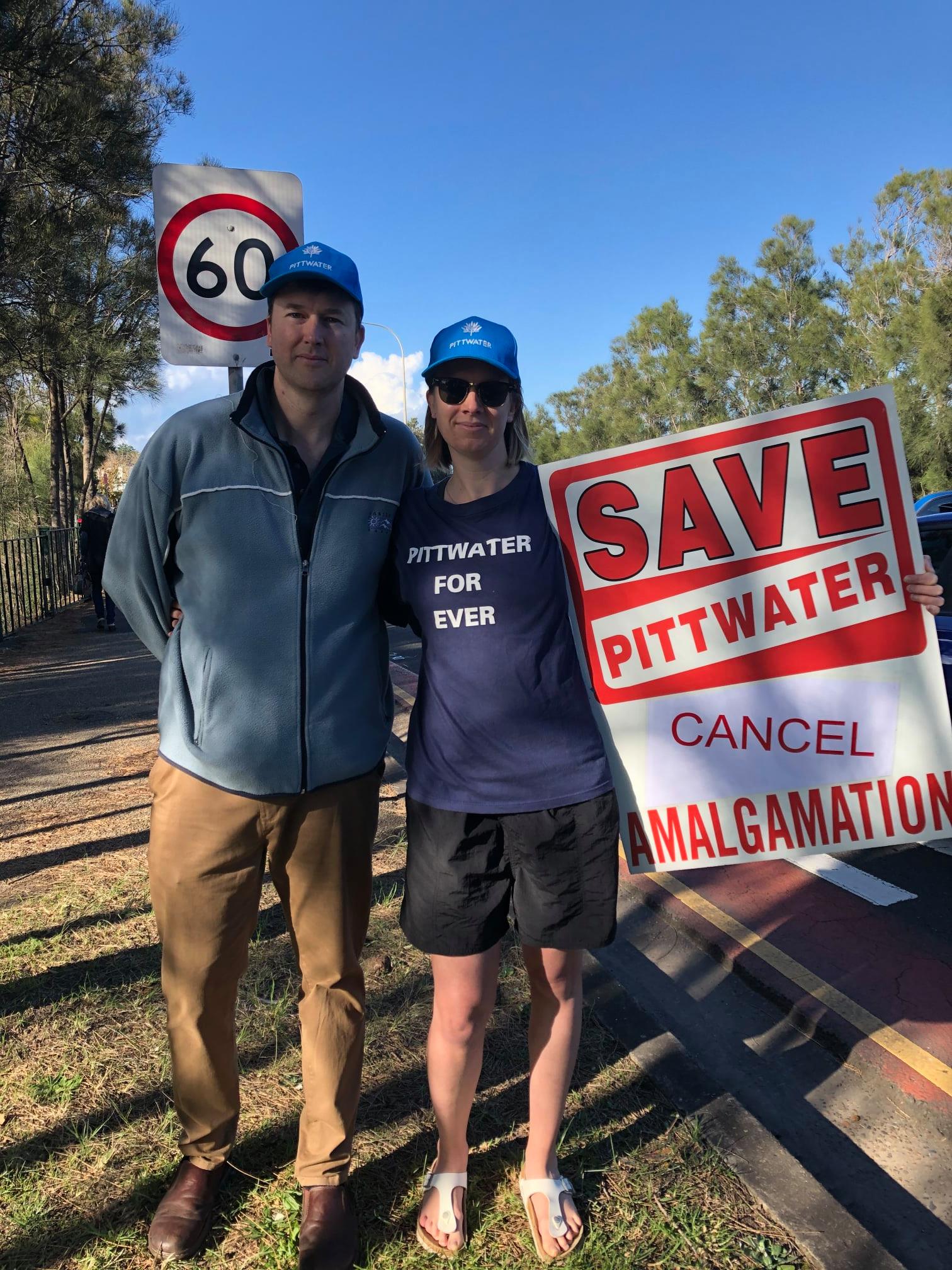
Simon and Hannah Dunn
